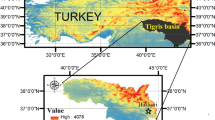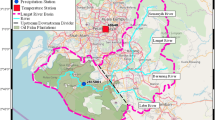Abstract
Relative humidity (RH) has an important effect on precipitation, especially in arid and semiarid regions. Prediction of RH has been the focus of attention of climate change researchers as well. In this investigation, the accuracy of six intelligent models, including an artificial neural network (ANN), a co-active neuro-fuzzy inference system (CANFIS), principal component analysis (PCA) combined with ANN (PCA–ANN) and three hybrid wavelet-artificial intelligence models, including WANN, WCANFIS and WPCA–ANN, was evaluated in daily RH prediction. Thirty weather stations located in different climates in Iran for the period 2000–2010 were selected for the evaluation and comparison of these models. The performance of each model was evaluated using correlation coefficient (r) and normal root mean square error (NRMSE). Based on the statistical evaluation criteria, the accuracy ranks of the six models were: WPCA–ANN, WCANFIS, WANN, PCA–ANN, ANN and CANFIS. The results indicated that the WPCA–ANN model was the optimal model for estimation of RH, and the range of NRMSE and r values were from 0.009 to 0.080 and from 0.996 to 0.999, respectively. Overall, WPCA–ANN is a new approach that can be successfully applied to predict RH with a high accuracy.








Similar content being viewed by others
References
Akbary M (2015) Combinatory Mediterranean-Sudanese systems role in the occurrence of heavy rainfalls (case study: south west of Iran). Meteorol Atmos Phys 127(6):675–683
Alizadeh MJ, Kavianpour MR, Kisi K, Nourani V (2017) A new approach for simulating and forecasting the rainfall-runoff process within the next two months. J Hydrol 548:588–597
Areerachakul S (2012) Comparison of ANFIS and ANN for estimation of biochemical oxygen demand parameter in surface water. Changes 257:13365
Aytek A (2008) Co-active neurofuzzy inference system for evapotranspiration modeling. A fusion of foundations. Methodologies and applications. Soft Comput 13(7):691–700
Bayazit M, Aksoy H (2001) Using wavelets for data generation. J Appl Stat 28:157–166
Cannas B, Fanni A, See L, Sias G (2006) Data preprocessing for river flow forecasting using neural networks: wavelet transforms and data partitioning. Phys Chem Earth 31(18):1164–1171
Chaudhuri S, Chattopadhyay S (2005) Neuro-computing based short range prediction of some meteorological parameters during the pre-monsoon season. A fusion of foundations methodologies and applications. Soft Comput 9(5):349–354
Chen J, Chen C (2017) Uncertainty analysis in humidity measurements by the psychrometer method. Sensors 17(368):2–19
Citakoglu H (2016) Comparison of artificial intelligence techniques for prediction of soil temperatures in Turkey. Theor Appl Climatol 1:1–12
Critchfield H (1974) General climatology. Prentice-Hall, Englewood Cliffs
Elliott W, Angell J (1997) Variations of cloudiness, precipitable water, and relative humidity over the United States: 1973–1993. Geophys Res Lett 24(1):41–44
Gnana Sheela K, Deepa SN (2013) Review on methods to fix number of hidden neurons in neural networks. Math Probl Eng 2013:11
Haykin S (1999) Neural networks: a comprehensive foundation, 2nd edn. Prentice Hall, New Jersey
John VO, Soden BJ (2007) Temperature and humidity biases in global climate models and their impact on climate feedbacks. Geophys Res Lett 34:L18704. https://doi.org/10.1029/2007GL030429
Junior L, Souza R, Menezes M, Cassiano K (2015) Artificial neural network and wavelet decomposition in the forecast of global horizontal solar radiation. Pesqui Operacional 35(1):73–90
Karthika BS, Paresh CD (2016) Modeling of air temperature using ANFIS by wavelet refined parameters. Int J Intell Syst Appl 8(1):25–34
Katiraie Boroujerdy PS, Arkian F, Rezai F (2011) Trend of humidity (specific and relative) in synoptic stations in Iran in period 1976–2005. J Mar Sci Technol 6:17–29
Kaur A, Sharma JK, Agrawal S (2011) Artificial neural networks in forecasting maximum and minimum relative humidity. Int J Comput Sci Netw Secur 11(5):197–199
Kumar P, Kumar D, Tiwari AK (2012) Evaporation estimation using artificial neural networks and adaptive Neuro-Fuzzy inference system techniques. Pak J Meteorol 8:81–88
Loele G, De Luca M, Dinç E, Oliverio F, Ragno G (2011) Artificial neural network combined with principal component analysis for resolution of complex pharmaceutical formulations. Chem Pharm Bull (Tokyo) 59(1):35–40
Mba L, Meukam P, Kemajou A (2016) Application of artificial neural network for predicting hourly indoor air temperature and relative humidity in modern building in humid region. Energy Build 121:32–42
Milewski R, Jankowska D, Cwalina U, Milewska A, Citko D, Więsak T, Morgan A, Wołczyński S (2016) Application of artificial neural networks and principal component analysis to predict results of infertility treatment using the IVF method, studies in logic. Gramm Rhetor 47(1):33–46
Moghaddamnia A, GhafariGousheh M, Piri J, Amin S, Han D (2009) Evaporation estimation using artificial neural networks and adaptive neuro-fuzzy inference system techniques. Adv Water Resour 32(1):88–97
Moustris KP, Larissi LK, Nastos PT, Paliatsos AG (2011) Precipitation forecast using artificial neural networks in specific regions of greece. Water Resour Manag 25(8):1979–1993
Nourani N, HosseiniBaghanam A, Adamowski A, Kisi O (2014) Applications of hybrid wavelet–artificial intelligence models in hydrology: a review. J Hydrol 514:358–377
Okkan U, Serbes ZA (2013) The combined use of wavelet transform and black box models in reservoir inflow modeling. J Hydrol Hydromech 61(2):112–119
Papantoniou S, Kolokotsa D (2016) Prediction of outdoor air temperature using neural networks: application in 4 European cities. Energy Build 114:72–79
Patil A, Deka (2016) Performance evaluation of hybrid Wavelet-ANN and Wavelet-ANFIS models for estimating evapotranspiration in arid regions of India. Neural Comput Appl 28:275–285
Philippopoulos K, Deligiorgi D, Kouroupetroglou G (2015) Artificial neural network modeling of relative humidity and air temperature spatial and temporal distributions over complex terrains. Pattern Recognit Appl Methods 318:171–187
Premalatha N, Arasu A (2016) Prediction of solar radiation for solar systems by using ANN models with different back propagation algorithms. J Appl Res Technol 14(3):206–214
Ramana R, Krishna B, Kumar SR, Pandey NG (2013) Monthly rainfall prediction using wavelet neural network analysis. Water Resour Manag 27:3697–3711
Ranganayaki V, Deepa SN (2016) An intelligent ensemble neural network model for wind speed prediction in renewable energy systems. Sci World J 2016:1–14
Samer A, Tamer K (2012) Modeling of relative humidity using artificial neural network. Asian Econ Soc Soc 2(2):81–86
Shafaei M, Kisi O (2016) Predicting river daily flow using wavelet-artificial neural networks based on regression analyses in comparison with artificial neural networks and support vector machine models. Neural Comput Appl 28:1–14
Soden BJ, Jackson DL, Ramaswamy V (2005) The radiative signature of upper tropospheric moistening. Science 310:841–844
Tabari H, HosseinzadehTalaee P, Willems P (2014) Short-term forecasting of soil temperature using artificial neural network. Meteorol Appl 22(3):576–585
Tabari H, Willems P (2016) Daily precipitation extremes in Iran: decadal anomalies and possible drivers. J Am Water Resour Assoc 52:541–599
Takagi T, Sugeno M (1985) Fuzzy identification of systems and its applications to modeling and control. IEEE Trans Syst 15(1):116–132
Tokar AS, Markus M (2000) Precipitation runoff modeling using artificial neural network and conceptual models. J Hydrol Eng ASCE 5:156–161
Wang L, Kisi K, Zounemat-Kermani M, Li H (2017) Pan evaporation modeling using six different heuristic computing methods in different climates of China. J Hydrol 544:407–427
Xiao Yong, Xiaomin Gu, Yin Shiyang, Shao Jingli, Cui Yali, Zhang Qiulan, Niu Yong (2016) Geostatistical interpolation model selection based on ArcGIS and spatio–temporal variability analysis of groundwater level in piedmont plains, northwest China. Springer Plus 5(425):1–15
Yan Q, Ma C, Song Y, Zhou W (2016) Wavelet and ANFIS combination model for groundwater level forecasting. Revista Tecnica de la Facultad de Ingenieria Universidad del Zulia 39(2):317–328
Yousefi F, Mohammadiyan S, Karimi H (2016) Application of artificial neural network and PCA to predict the thermal conductivities of nanofluids. Heat and Mass Transf 52(10):2141–2154
Zareabyaneh H, Bayat-Varkeshi M, Golmohammadi G, Mohammadi K (2016) Soil temperature estimation using an artificial neural network and co-active neuro-fuzzy inference system in two different climates. Arab J Geosci 9(377):1–10
Zhang Q, Qi T, Li J, Singh V, Wang A (2015) Spatiotemporal variations of pan evaporation in China during 1960–2005: changing patterns and causes. Int J Climatol 35(6):903–912
Zhang Y, Li H, Hou A, Havel J (2006) Artificial neural networks based on principal component analysis input selection for quantification in overlapped capillary electrophoresis peaks. Chemom Intell Lab Syst 82(1):165–175
Zhou L, Ma W, Zhang H, Li L, Tang L (2015) Developing a PCA–ANN model for predicting chlorophyll a concentration from field hyperspectral measurements in Dianshan Lake, China. Water Qual Expos Health 7(4):591–602
Author information
Authors and Affiliations
Corresponding author
Ethics declarations
Conflict of interest
All authors declare that there is no conflict of interest.
Additional information
Publisher's Note
Springer Nature remains neutral with regard to jurisdictional claims in published maps and institutional affiliations.
Rights and permissions
About this article
Cite this article
Bayatvarkeshi, M., Mohammadi, K., Kisi, O. et al. A new wavelet conjunction approach for estimation of relative humidity: wavelet principal component analysis combined with ANN. Neural Comput & Applic 32, 4989–5000 (2020). https://doi.org/10.1007/s00521-018-3916-0
Received:
Accepted:
Published:
Issue Date:
DOI: https://doi.org/10.1007/s00521-018-3916-0




